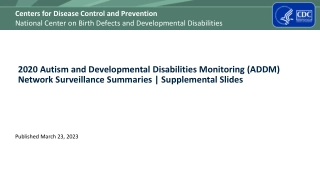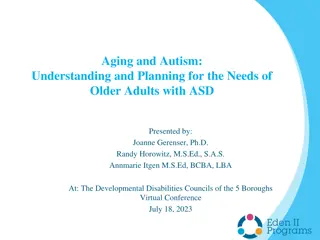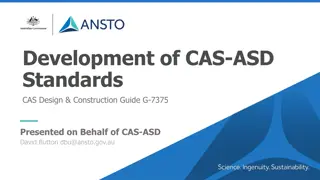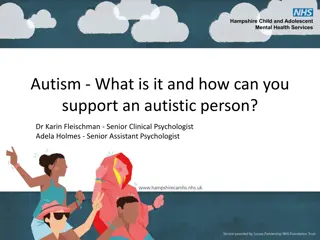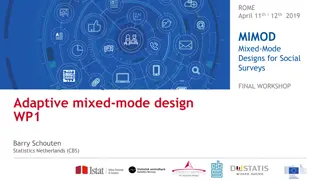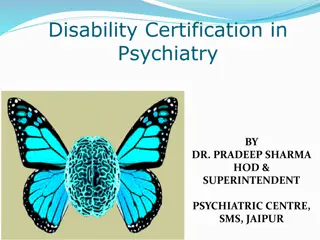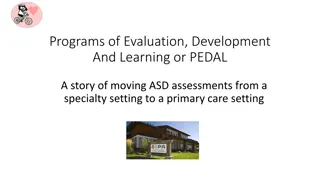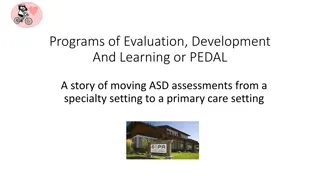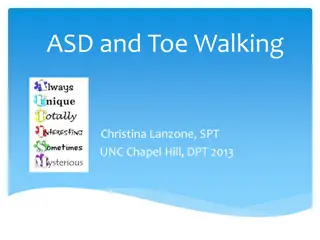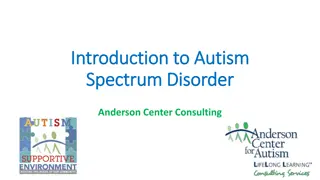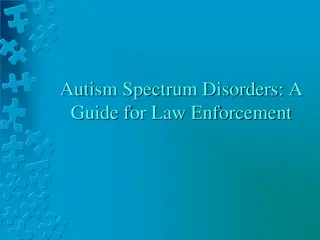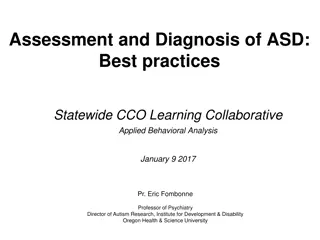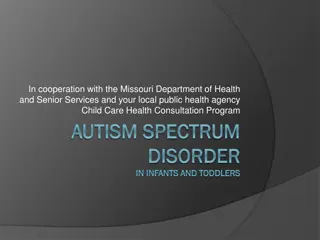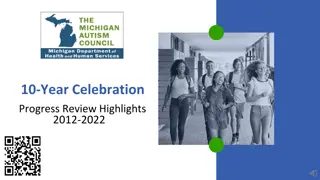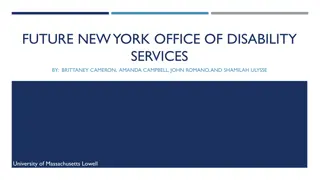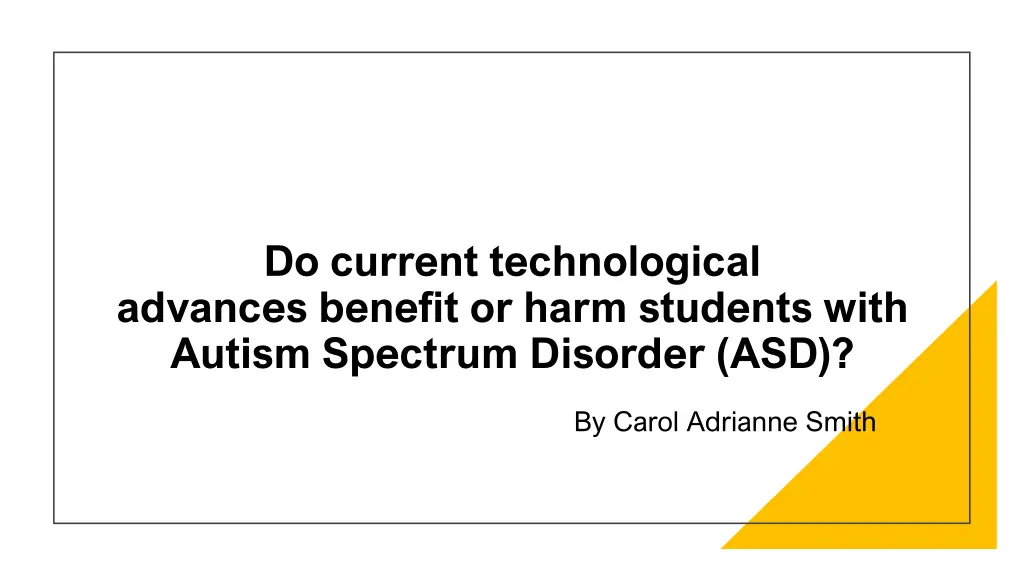
Technological Advances for Students with Autism Spectrum Disorder
Explore the impact of current technological advances on students with Autism Spectrum Disorder (ASD), focusing on how digital tools and mobile applications can benefit and support their learning and social skills. Learn about the potential of virtual reality, 3D animation, and other modern technologies to improve engagement, expression, and communication for individuals with ASD.
Download Presentation

Please find below an Image/Link to download the presentation.
The content on the website is provided AS IS for your information and personal use only. It may not be sold, licensed, or shared on other websites without obtaining consent from the author. If you encounter any issues during the download, it is possible that the publisher has removed the file from their server.
You are allowed to download the files provided on this website for personal or commercial use, subject to the condition that they are used lawfully. All files are the property of their respective owners.
The content on the website is provided AS IS for your information and personal use only. It may not be sold, licensed, or shared on other websites without obtaining consent from the author.
E N D
Presentation Transcript
Do current technological advances benefit or harm students with Autism Spectrum Disorder (ASD)? By Carol Adrianne Smith
Background 2 Neurophysiological condition Developmental disorder Difficulty with communication and interaction with other people Restricted interests and repetitive behaviors Symptoms that affect their ability to function in school, work, and other areas of life 1. Autism Spectrum Disorder (ASD) Presentation | PPT (slideshare.net) 2. NIMH Autism Spectrum Disorder (nih.gov)
Autism is categorized as a spectrum disorder because there is wide variation in the type and severity of symptoms people experience.2 According to the Diagnostic and Statistical Manual of Mental Disorders (DSM-5), of the American Psychiatric Association People of all genders, races, ethnicities, and economic backgrounds can be diagnosed with ASD. Although ASD can be a lifelong disorder, treatments and services can improve a person s symptoms and daily functioning.2 2. NIMH Autism Spectrum Disorder (nih.gov)
Literature Reviews
Literature review: Digital and Mobile Applications for Autism Inclusion. International Journal of Online and Biomedical Engineering Difficulties faced by both autistic people and teachers were analyzed. There is a need for various autistic technological pedagogic styles to aid in lesson design and delivery style 4. Technological tools develop social and organizational skills4 o For example, videos can make recognizing facial expressions, body language, and voice easier 4. o Speech- or voice-output communication devices can help children express themselves and get around the difficulty of spoken communication 4. Major improvements in engagement, expression, and communication are a viable option due to modern technologies, including virtual reality, 3D animation, collaborative virtual environments, 3D avatars, and web apps 4. 4. Moraiti, Ioanna & Fotoglou, Anestis & Drigas, Athanasios. (2023). Digital and Mobile Applications for Autism Inclusion. International Journal of Online and Biomedical Engineering (iJOE). 19. 83-95. 10.3991/ijoe.v19i11.379
Literature Review Supporting students with ASD in mathematics learning using video-based concrete-representational-abstract sequencing instruction, Preventing School Failure: Alternative Education for Children and Youth 5 Methods to teach students with ASD, it is necessary to provide them with evidence-based, individualized mathematics instruction tailored to their unique needs.5 Concrete-representational-abstract (CRA) sequencing instruction with video-based instruction5 Through CRA educators can sequentially teach mathematics through three stages of learning: concrete manipulations, pictorial representations, and abstract notations with video-based instructions (VBI) in teaching mathematics 5 VB-CRA increases students learning by providing focused, explicit instruction with clear, concise, and consistent mathematics language without expecting parental homework assistance 5 . Gulnoza Yakubova, Elizabeth M. Hughes & Briella L. Baer (2020) Supporting students with ASD in mathematics learning using video-based concrete- representational-abstract sequencing instruction, Preventing School Failure: Alternative Education for Children and Youth, 64:1, 12- 18, DOI: 10.1080/1045988X.2019.1627999
If appropriately implemented, technological advances will then assist the heterogeneity of autistic students while not mentally overstimulating them during the learning process. Hypothesis
Seven Principles of Teaching and Learning (Chickering & Gramson, 1987) Encourages contact between students and faculty Develops reciprocity and cooperation among students Encourages active learning Gives Prompt Feedback Emphasizes Time on Task Communicates High Expectations Respects Diverse Talents and Ways of Learning
Challenges and complexity of implementing the seven principles of learning with autistic students Due to the spectrums of autism More creative approach to implementing the seven principles for learning. For example, due to social limitations affecting my hypothesis, it will be necessary to be careful about the allotment of time with all students during the case study structure exercise time playtime with non-autistic children highly recommended
Challenging Problems to address for autistic students Do technological advances improve autistic learning skills faster than the traditional paper and pencil method? Giving possible free time to focus on improving their social skills, since being antisocial is a hindering autistic trait. Which technological designs are more favorable or not favorable, and why How do we test the success or lack of success of each technologically introduced technique
The case study will grant accessibility to all ethnicities by eliminating economic disadvantages It is a fact that a disproportional number of African American students with autism are economically disadvantage6 Case summer study is economically non-based so that all ethnicities can benefit. No child or student will be left behind due to not being able to afford participation in the study. It will be free. Racial economic bias against certain subjects with autism can hope to be avoided. It will be a mixture of several different ages.
Summer case study During the several years of the case study, the data collected in the summer can be positively implemented during the school year to help autistic students eliminate the barriers they face in the regular classroom. To be equitable to both groups, they will alternate with technology access so that data can be used and collected to benefit both groups during the summer months. The time will be equally divided per the case study.
Summer Experimental Design Groups Methodology Pencil and Paper Group 10 ASD students 60 min Pencil and Paper learning No technology Lecture via professor with paper and pencil learning physical sciences 15 minutes structured physical exercise 30 minutes social playtime with nonautistic students 30 Lunch time Daily and Monthly Assessment Technology Group 10 ASD students Computer and Video 60 min a day computer instruction with audio and examples able to be repetitively played for physical sciences 15 min structured physical exercise 30 minutes social playtime with nonautistic children 30 Lunch time Daily and monthly assessment
Methodological material web-based learning tools Web applications created for autistic people to be used: Proloquy: series speaks words as one writes control content 4 Keeble: accessible keyboard for mobile limitations 4 Avaz: Speech visual grid to rearrange into phrases 4 Video recording Responsive computer software Useful application according to their need for educators and individuals https://apollobehavior.com/best-autism-apps 4
Concise Individualized Education Program (IEP) An IEP details a learning program of special education instruction, to support and make progress to thrive in school. IEPs are covered by special education law, or the Individuals with Disabilities Education Act (IDEA). IEPs are created for students that attend public school, which includes charter schools. What is an IEP? (understood.org) What is an IEP? (understood.org)7
Qualitative and Quantitative Leiter Assessments to measure ASD Purpose: Pre and post assessments Measures intelligence and cognitive abilities 3 to 75 years 8 8. Mazurek, M.O., Kanne, S.M. (2018). Leiter International Performance Scale, Third Edition. In: Kreutzer, J., DeLuca, J., Caplan, B. (eds) Encyclopedia of Clinical Neuropsychology. Springer, Cham. https://doi.org/10.1007/978-3-319-56782-2_1562-2
Conclusional Analysis Summer study to assist the autistic students create IEPs or personal lesson plans of success for during the school year with different learning styles to succeed in the standard classroom Mini test per each exercise can be accurate assessments of progression provides quantitative and qualitative Leiter test measure on a larger scale at program begin and end quantitative and qualitative assessments Overall, in this case study, an improved qualitative and quantitative guide to successful autistic learning styles is a determinable expected outcome. Social elements which most autistic children need are observed with nonautistic children. Did the technology help them mentally? Detailed IEP learning styles created for students during their academic years
References 1.Autism Spectrum Disorder (ASD) Presentation | PPT (slideshare.net) 2. NIMH Autism Spectrum Disorder (nih.gov) 3. Resistance is Futile (wildapricot.org) 4.Moraiti, Ioanna & Fotoglou, Anestis & Drigas, Athanasios. (2023). Digital and Mobile Applications for Autism Inclusion. International Journal of Online and Biomedical Engineering (iJOE). 19. 83-95. 10.3991/ijoe.v19i11.37895. 5.Gulnoza Yakubova, Elizabeth M. Hughes & Briella L. Baer (2020) Supporting students with ASD in mathematics learning using video-based concrete-representational-abstract sequencing instruction, Preventing School Failure: Alternative Education for Children and Youth, 64:1, 12- 18, DOI: 10.1080/1045988X.2019.1627999 6. Mazurek, M.O., Kanne, S.M. (2018). Leiter International Performance Scale, Third Edition. In: Kreutzer, J., DeLuca, J., Caplan, B. (eds) Encyclopedia of Clinical Neuropsychology. Springer, Cham. https://doi.org/10.1007/978-3-319-56782-2_1562-2 7. What is an IEP? (understood.org) 8. McConachie H, Parr JR, Glod M, et al. Systematic review of tools to measure outcomes for young children with autism spectrum disorder. Southampton (UK): NIHR Journals Library; 2015 Jun. (Health Technology Assessment, No. 19.41.) Available from: https://www.ncbi.nlm.nih.gov/books/NBK299302/ doi: 10.3310/hta19410
The End Thank you for attending my presentation Questions?

